The cetaceans (whales, dolphins and porpoises) are descendants of land-living mammals. Their terrestrial origins are specifically indicated by:
- Their need to breathe air from the surface;
- The bones of their fins, which resemble the jointed hands of land mammals; and
- The vertical movement of their spines, characteristic more of a running mammal than of the horizontal movement of fish.
The question of how land animals evolved into ocean-going leviathans had been a mystery for a long time, owing to gaps in the fossil record. However, recent discoveries in Pakistan have managed to solve many of these mysteries, and it is now possible to see several stages in the transition of the cetaceans from land to sea.
Earliest ancestors[]
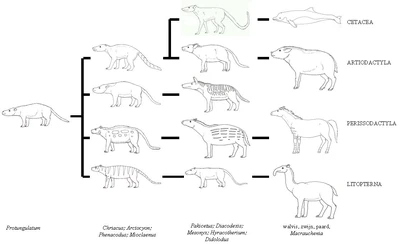
The family tree, including Ungulates.
The traditional theory of cetacean evolution was that whales were related to the mesonychids, an extinct order of carnivorous ungulates (hoofed animals), which looked rather like wolves with hooves and were a sister group of artiodactyls. These animals possessed unusual triangular teeth that are similar to those of whales. For this reason, scientists had long believed that whales evolved from a form of mesonychid; however more recent molecular phylogeny data suggest that whales are more closely related to the artiodactyls, specifically the hippopotamus.[1] The strong evidence for a clade combining cetaceans and artiodactyls is further discussed under the entry Cetartiodactyla. However, hippos' anthracothere ancestors do not appear in the fossil record until millions of years after Pakicetus, the first known whale ancestor.
The recent discovery of Pakicetus, the earliest proto-whale (see below) supports the molecular data. The skeletons of Pakicetus demonstrate that whales did not derive directly from mesonychids. Instead, they are a form of artiodactyl (another type of ungulate) that began to take to the water after the artiodactyl family split from the mesonychids. In other words, the proto-whales were early artiodactyls that retained aspects of their mesonychid ancestry (such as the triangular teeth) which modern artiodactyls have since lost. An interesting implication is that the earliest ancestors of all hoofed mammals were probably at least partly carnivorous or scavengers, today's artiodactyls and perissodactyls having switched to a plant diet later in their evolution. Whales, due to the readier availability of animal prey and their need for higher caloric content to live as marine endotherms, naturally retained their carnivorous diet, as did mesonychids, who were however out-competed by better-adapted animals like the Carnivora later on (mesonychids became specialized carnivores when the overall availability of large animal prey was still low; thus their adaptation was likely at a disadvantage when new forms had filled the gaps left by the dinosaurs).
The earliest cetaceans: Pakicetids or Indohyus?[]

Reconstruction of Pakicetus
The pakicetids are hoofed-mammals that are sometimes classified as the earliest whales.[2][3] They lived in the early Eocene, around 53 million years ago. They looked rather like dogs with hoofed feet and long, thick tails. They have been linked to whales by their ears: the structure of the auditory bulla is formed from the ectotympanic bone only. The shape of the ear region in Pakicetus is highly unusual and only resembles the skulls of whales. The feature is diagnostic for cetaceans and is found in no other species. It was initially thought that the ears of Pakicetus were adapted for underwater hearing, but, as would be expected from the anatomy of the rest of this creature, the ears of Pakicetus are specialized for hearing on land, and if Pakicetus is related to the ancestors of whales, underwater hearing must have been a later adaptation.[4] According to Thewissen, the teeth of Pakicetus also resemble the teeth of fossil whales, being less like a dog's incisors, with a serrated triangular shape, similar to a shark's tooth, which is another link to more modern whales.[5]

Reconstruction of Indohyus.
Thewissen has since found the same ear structure in fossils of a small deer-like creature, Indohyus, which lived about 48 million years ago in Kashmir.[3] About the size of a raccoon or domestic cat, this herbivorous creature shared some of the traits of whales, and showed signs of adaptations to aquatic life, including a thick and heavy outer coating to bones which is similar to the bones of modern creatures such as the hippopotamus,[6][7] and reduces buoyancy so that they can stay underwater. This suggests a similar survival strategy to the African mousedeer or water chevrotain which, when threatened by a bird of prey, dives into water and hides beneath the surface for up to four minutes.[8][9][10]
Ambulocetuds and remingtonocetids[]

Reconstruction of Kutchicetus, a remingtonocetid

Reconstruction of Ambulocetus natans
The most remarkable of the recent discoveries in Pakistan has been Ambulocetus, which looked like a three-metre long mammalian crocodile. Ambulocetus was clearly amphibious, as its back legs are better adapted for swimming than for walking on land, and it probably swam by undulating its back vertically, as otters, seals and whales do. It has been speculated that Ambulocetids hunted like crocodiles, lurking in the shallows to snatch unsuspecting riparian prey and fish.
A smaller cousin of Ambulocetus was the remingtonocetid family, which had longer snouts than Ambulocetus's, and were slightly better adapted for underwater life. It has been speculated that they lived like modern sea otters, hunting for fish in the shallows.
In both groups, the nasal openings were at the tip of the snout, like in land-mammals.
Protocetids[]
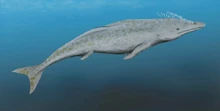
Reconstruction of Protocetus
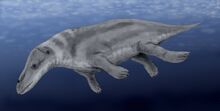
Reconstruction of Rodhocetus
The protocetids form a diverse and heterogeneous group known from Asia, Europe, Africa, and North America. There were many genera, and some of these are very well known (e.g., Rodhocetus). Known protocetids had large fore- and hindlimbs that could support the body on land, and it is likely that they lived amphibiously: in the sea and on land. It is unclear at present whether protocetids had flukes (the horizontal tail fin of modern cetaceans). However, what is clear, is that they are adapted even further to an aquatic life-style. In Rodhocetus, for example, the sacrum – a bone that in land-mammals is a fusion of five vertebrae that connects the pelvis with the rest of the vertebral column – was divided into loose vertebrae. However, the pelvis was still connected to one of the sacral vertebrae. Furthermore, the nasal openings are now halfway up the snout; a first step towards the telescoped condition in modern whales. Their supposed amphibious nature is supported by the discovery of a pregnant Maiacetus[11], in which the fossilised fetus was positioned for a head-first delivery, suggesting that Maiacetus gave birth on land. The ungulate ancestry of these early whales is still underlined by characteristics like the presence of hoofs at the ends of toes in Rodhocetus.
Basilosaurids and dorudontids: fully marine cetaceans[]
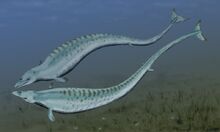
Reconstruction of Basilosaurus
Basilosaurus (discovered in 1840 and initially mistaken for a reptile, hence its name) and Dorudon lived around 38 million years ago, and were fully recognizable whales which lived entirely in the ocean. Basilosaurus was as big as the larger modern whales, up to Template:Convert/m long; dorudontids were smaller, about Template:Convert/m long.

Reconstruction of Dorudon
Although they look very much like modern whales, basilosaurids and dorudontids lacked the 'melon organ' that allows their descendants to use echolocation as effectively as modern whales. They had small brains; this suggests they were solitary and did not have the complex social structure of some modern cetaceans. Basilosaurus had two tiny but well-formed hind legs which were probably used as claspers when mating; they are a small reminder of the lives of their ancestors. Interestingly, the pelvic bones associated with these hind limbs was now no longer connected to the vertebral column as it was in protocetids. Essentially, any sacral vertebrae can no longer be clearly distinguished from the other vertebrae.
Early echolocation[]
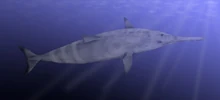
Reconstruction of Squalodon
Toothed whales (Odontocetes) echolocate by creating a series of clicks emitted at various frequencies. Sound pulses are emitted through their melon-shaped foreheads, reflected off objects, and retrieved through the lower jaw. Skulls of Squalodon show evidence for the first hypothesized appearance of echolocation. Squalodon lived from the early to middle Oligocene to the middle Miocene, around 33-14 million years ago. Squalodon featured several commonalities with modern Odontocetes. The cranium was well compressed, the rostrum telescoped outward (a characteristic of the modern suborder Odontoceti), giving Squalodon an appearance similar to that of modern toothed whales. However, it is thought unlikely that squalodontids are ancestors of living dolphins.
Early baleen whales[]

Reconstruction of Cetotherium
All modern mysticetes are large filter-feeding or baleen whales, though the exact means by which baleen is used differ among species (gulp-feeding with balaenopterids, skim-feeding with balaenids, and bottom ploughing with eschrichtiids). The first members of some modern groups appeared during the middle Miocene. These changes may have been a result of worldwide environmental change and physical changes in the oceans. A large scale change in ocean current and temperature could have initiated the radiation of modern mysticetes, leading to the demise of the archaic forms. Generally it is thought the four modern mysticete families have separate origins among the cetotheres, however this is only speculative. Modern baleen whales, Balaenopteridae (rorquals and humpback whale, Megaptera novaengliae), Balaenidae (right whales), Eschrichtiidae (gray whale, Eschrictius robustus), and Neobalaenidae (pygmy right whale, Caperea marginata) all have derived characteristics presently unknown in any cetothere.
Early dolphins[]
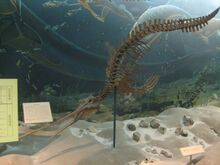
Skeleton of Xiphiacetus sp.
During the early Miocene, echolocation developed in its modern form. Various extinct dolphin-like families flourished. Early dolphins include Kentriodon and Hadrodelphis. These belong to Kentriodontidae, which were small to medium-sized toothed cetaceans with largely symmetrical skulls, and thought likely to include ancestors of some modern species. Kentriodontids date to the late Oligocene to late Miocene. Kentriodontines ate small fish and other nectonic organisms; they are thought to have been active echolocators, and might have formed schools. Diversity, morphology and distribution of fossils appear parallel to some modern species.
Skeletal evolution[]
Today, the whale hind parts are internal and reduced, and they serve as anchor for the muscles of the genitalia. Occasionally, the genes that code for longer extremities cause a modern whale to develop miniature legs (known as atavism).
Whereas early cetaceans such as the Pakicetus had the nasal openings at the end of the snout, in later species such as the Rodhocetus, the openings had begun to drift toward the top of the skull. This is known as nasal drift.
The nostrils of modern whales have become modified into blowholes that allow them to break to the surface, inhale, and submerge with convenience. The ears began to move inward as well, and, in the case of Basilosaurus, the middle ears began to receive vibrations from the lower jaw. Today's modern toothed whales use the 'melon organ', a pad of fat, for echolocation.
See also[]
- Archaeoceti
- Aquatic adaptation
- Indohyus
- Transitional form
- Evolution of sirenians
- Evolution of mammals
- List of extinct cetaceans
References[]
- ^ Template:Cite-web
- ^ Philip D. Gingerich, D. E. Russell (1981). "Pakicetus inachus, a new archaeocete (Mammalia, Cetacea) from the early-middle Eocene Kuldana Formation of Kohat (Pakistan)". Univ. Mich. Contr. Mus. Paleont 25: 235–246.
- ^ a b Northeastern Ohio Universities Colleges of Medicine and Pharmacy (2007, December 21). "Whales Descended From Tiny Deer-like Ancestors". ScienceDaily. http://www.sciencedaily.com/releases/2007/12/071220220241.htm. Retrieved on 2007-12-21.
- ^ J. G. M. Thewissen, E. M. Williams, L. J. Roe and S. T. Hussain (2001). "Skeletons of terrestrial cetaceans and the relationship of whales to artiodactyls". Nature 413: 277–281. doi:.
- ^ Whale Origins
- ^ University Of Michigan (2001, September 20). "New Fossils Suggest Whales And Hippos Are Close Kin". ScienceDaily. http://www.sciencedaily.com/releases/2001/09/010920072245.htm. Retrieved on 2007-12-21.
- ^ University Of California, Berkeley (2005, February 7). "UC Berkeley, French Scientists Find Missing Link Between The Whale And Its Closest Relative, The Hippo". ScienceDaily. http://www.sciencedaily.com/releases/2005/02/050205103109.htm. Retrieved on 2007-12-21.
- ^ Carl Zimmer (2007-12-19). "The Loom : Whales: From So Humble A Beginning...". ScienceBlogs. http://scienceblogs.com/loom/2007/12/19/whales_from_so_humble_a_beginn.php. Retrieved on 2007-12-21.
- ^ Ian Sample (2007-12-19). "Whales may be descended from a small deer-like animal". Guardian Unlimited. http://www.guardian.co.uk/science/2007/dec/19/whale.deer?gusrc=rss&feed=networkfront. Retrieved on 2007-12-21.
- ^ PZ Myers (2007-12-19). "Pharyngula: Indohyus". Pharyngula. ScienceBlogs. http://scienceblogs.com/pharyngula/2007/12/indohyus.php. Retrieved on 2007-12-21.
- ^ Gingerich PD, ul-Haq M, von Koenigswald W, Sanders WJ, Smith BH, et al.. "New Protocetid Whale from the Middle Eocene of Pakistan: Birth on Land, Precocial Development, and Sexual Dimorphism". PLoS one. http://www.plosone.org/article/info%3Adoi%2F10.1371%2Fjournal.pone.0004366. Retrieved on 2009-02-04.
External links[]
- Cetacean Paleobiology - University of Bristol
- BBC: Whale's evolution
- Hooking Leviathan by Its Past by Stephen Jay Gould
- Whale Origins, Thewissen Lab, Northeastern Ohio Universities College of Medicine
- Digital Library of Dolphin Development, Thewissen Lab
- Research on the Origin and Early Evolution of Whales (Cetacea), Gingerich, P.D., University of Michigan
- Evolution of Whales Adapted from National Geographic, November 2001, Revised 2006 Dr. J.G.M. Thewissen
- Pakicetus inachus, a new archaeocete (Mammalia, Cetacea) from the early-middle Eocene Kuldana Formation of Kohat (Pakistan). Gingerich, P.D., 1981, Museum of Paleontology, The University of Michigan
- Skeletons of terrestrial cetaceans and the relationship of whales to artiodactyls, Nature 413, 277-281 (20 September 2001), J. G. M. Thewissen, E. M. Williams, L. J. Roe and S. T. Hussain
- Evolution of Whales segment from the Whales Tohorā Exhibition Minisite of the Museum of New Zealand Te Papa Tongarewa